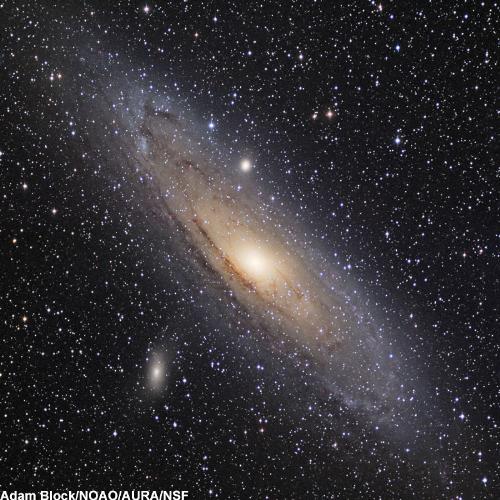The Andromeda Galaxy
By FireHorse
@FireHorse (293)
United States
May 4, 2007 11:42am CST
Most galaxies are racing away from each other. The Andromeda galaxy is the exception in our local group, it's coming towards us. No need for panic just yet, we've got about three billion years before the Milky Way and Andromeda collide. Actual stellar collisions are unlikely, however, each galaxy has a super massive black hole in their centers which will restart and begin feeding again as they collide. The three most likely possibilities for our own sun during this collision are falling into one of the black holes, being thrown clear into inter-galactic space or landing happily into a new orbit around the new galactic center (the best scenerio for life on this planet). Do you think 3 billion years is long enough for the human race to get it's act together for interstellar travel?
2 people like this
4 responses
@steerforth (1797)
• Italy
4 May 07
The Andromeda Galaxy is a spiral galaxy approximately 2.5 million light-years away in the constellation Andromeda. It is the nearest spiral galaxy to our own, the Milky Way.
Andromeda was believed to be the largest galaxy of the Local Group of galaxies, which consists of the Andromeda Galaxy, the Milky Way Galaxy, and the Triangulum Galaxy, and about 30 other smaller galaxies. Due to recent findings based on improved measurements and data, scientists now believe that the Milky Way contains more dark matter and may be the most massive in the grouping. However, recent observations by the Spitzer Space Telescope revealed that M31 contains one trillion (1012) stars, greatly exceeding the number of stars in our own galaxy.
The Andromeda Galaxy is easily visible to the naked eye in a moderately dark sky, though such a sky is available only in smaller towns and isolated areas reasonably far from population centers and sources of light pollution. It appears quite small without a telescope because only the central part is bright enough to be visible, but the full angular diameter of the galaxy is seven times that of the full moon. It is generally considered to be the penultimate distant object visible to the naked eye after Triangulum.
I think that 3 billion years is too much long.
3 people like this
@mattithyahu (389)
• United States
8 May 07
Here is an awesome simulation of what happens when two spiral galaxies collide: http://www-news.uchicago.edu/releases/06/images/stelios4.jpg
Of course this is a perfect, edge-on collision which wouldn't necessarily happen.
2 people like this
@dnatureofdtrain (5273)
• Janesville, Wisconsin
13 Nov 07
Neat illustration there.. kind of reminds of the black holes colliding one I seen before too - DNatureofDTrain
@green_lightning (130)
• United States
1 Jan 08
yeah then when they become a a football shaped galaxy then another one will hit fun huh!
2 people like this
@astaha (129)
• India
31 Dec 07
sorry but if u have to believe in this theory u r ought to neglect the expanding universe theory or else neglect this one.
sorry but unfortunately no scientist have any alternative.
obviously there is no 3rd way out.or if there is some informative stuff savig both the theories from colision then let us know.
blessings.
2 people like this









